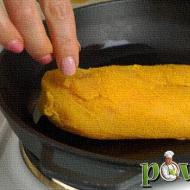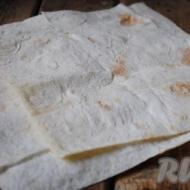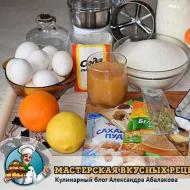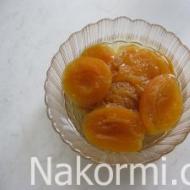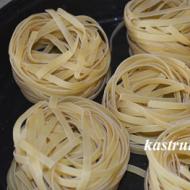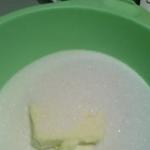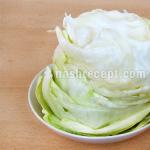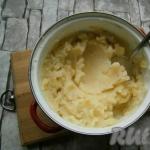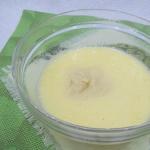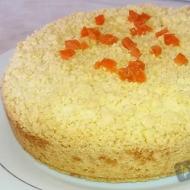
Quant. Coffee. Coffee and Naples. Coffee maker – “Caffetiera Napoletana” Antique Neapolitan coffee maker “Napoletana”
Step 1: Grind the coffee beans.
One of the secrets of making this amazing coffee. This is a special device - a coffee maker, which consists of two vessels, between which there is 2 mesh filters, where finely ground Neapolitan coffee is poured and, unfortunately, without this device, it is impossible to brew real Neapolitan coffee. But don’t worry, you can buy such a coffee maker in supermarkets and online stores. To begin, take a package of real Neapolitan coffee and open it with scissors. Take a bean grinder and grind the beans to a fine powder.
To begin, take a package of real Neapolitan coffee and open it with scissors. Take a bean grinder and grind the beans to a fine powder.  And the second secret, in order for the coffee to be a success, grind the coffee through a coffee grinder twice, first the grains and then the resulting mass.
And the second secret, in order for the coffee to be a success, grind the coffee through a coffee grinder twice, first the grains and then the resulting mass. Step 2: prepare a cup for Neapolitan coffee.
 Take a cup with thick walls. Why thick walls? Because the coffee in such a cup will cool down more slowly, and you will be able to prolong your pleasure from drinking it. And one more secret - dial half a teaspoon freshly ground coffee and pour it into a clean, dry cup.
Take a cup with thick walls. Why thick walls? Because the coffee in such a cup will cool down more slowly, and you will be able to prolong your pleasure from drinking it. And one more secret - dial half a teaspoon freshly ground coffee and pour it into a clean, dry cup. Step 3: brew coffee.
 Separate the two halves of the coffee pot, the bottom without a spout from the bottom with a spout. Pull out the filter. Unscrew the filter cap and pour into it 2 tablespoons fresh finely ground coffee and close the filter lid. Pour into the bottom cup without spout 200 milliliters of water. Do not fill the bowl above the vent level! Place the filter back into the container filled with water. Screw the bowl with the spout onto the bowl filled with water. In this case, the nose should look down. Turn the stove on high and place the coffee maker on it. Bring the water to a boil; when it boils, you will hear it by a characteristic gurgling sound. Remove the coffee maker from the stove. Once the steam has escaped from the vent, which will happen in about 30 – 40 seconds, turn the coffee maker upside down and let the coffee pass through the filters, drop by drop, for 7 – 10 minutes. Remove the top block and pour yourself a cup of aromatic coffee through a sieve. The raw coffee that remains at the bottom of the cup will rise to the top, stir the resulting aromatic mass with a teaspoon and wait 1 moment, until the fresh coffee settles to the bottom of the cup. The fresh aroma of brewed coffee and the light but quite perceptible aroma of freshly ground coffee combine and you will feel an indescribable fan of the smells of real Neapolitan coffee.
Separate the two halves of the coffee pot, the bottom without a spout from the bottom with a spout. Pull out the filter. Unscrew the filter cap and pour into it 2 tablespoons fresh finely ground coffee and close the filter lid. Pour into the bottom cup without spout 200 milliliters of water. Do not fill the bowl above the vent level! Place the filter back into the container filled with water. Screw the bowl with the spout onto the bowl filled with water. In this case, the nose should look down. Turn the stove on high and place the coffee maker on it. Bring the water to a boil; when it boils, you will hear it by a characteristic gurgling sound. Remove the coffee maker from the stove. Once the steam has escaped from the vent, which will happen in about 30 – 40 seconds, turn the coffee maker upside down and let the coffee pass through the filters, drop by drop, for 7 – 10 minutes. Remove the top block and pour yourself a cup of aromatic coffee through a sieve. The raw coffee that remains at the bottom of the cup will rise to the top, stir the resulting aromatic mass with a teaspoon and wait 1 moment, until the fresh coffee settles to the bottom of the cup. The fresh aroma of brewed coffee and the light but quite perceptible aroma of freshly ground coffee combine and you will feel an indescribable fan of the smells of real Neapolitan coffee. Step 4: Serve coffee Neapolitan style.
 Neapolitan coffee served hot. It is poured into cups with thick walls so that it maintains its temperature and can infuse for 1 minute with fresh ground Neapolitan coffee beans. This type of coffee is served without sugar. Jam, sugar, crackers or anything sweet is placed separately in plates or vases. A pleasant drink for the morning to invigorate and fill up with strength. Bon appetit!
Neapolitan coffee served hot. It is poured into cups with thick walls so that it maintains its temperature and can infuse for 1 minute with fresh ground Neapolitan coffee beans. This type of coffee is served without sugar. Jam, sugar, crackers or anything sweet is placed separately in plates or vases. A pleasant drink for the morning to invigorate and fill up with strength. Bon appetit! - − Sometimes, for those who like it sweeter, sugar is allowed in Neapolitan coffee, but it is not added to the cup of coffee after preparing the drink. Sugar is poured into a bowl with water, the water is brought to a boil and passed through filters with coffee. It turns out very sweet and tasty coffee.
- − In order to brew Neapolitan coffee, you do not have to use Neapolitan coffee. If you have a Neapolitan coffee maker, this drink can be brewed with any very high-quality type of coffee.
- − When preparing this type of coffee, do not change the above recipe, as you may end up with a drink that is too bitter or too bland.
- Why do you need to strain coffee after it has been brewed? This process is necessary to ensure that there is less unnecessary sediment in the cup. The old brewed coffee is removed and the decoction itself is poured into the bowl, it is infused for 1 minute with fresh ground coffee, which eventually settles as sediment at the bottom of the cup, but at the same time gives the freshness and tart aroma of coffee beans.
Varlamov A., Balestrino J. Physics of coffee preparation // Quantum. - 2001. - No. 4. - P. 2-7.
By special agreement with the editorial board and editors of the journal "Kvant"
The international traveler may notice that in this age of standardization and the dominance of transnational monopolies, when the same soft drinks are served in New York and Kathmandu, the coffee market remains surprisingly varied and varied. The drink from the same coffee beans is prepared and drunk differently in Turkey and Egypt, in Italy and France, in Finland and the USA. When you order coffee in a bar somewhere in Naples, you will receive an elegant cup slightly larger than a thimble, at the bottom of which a thick drop of almost black color, covered with delicious foam, slowly sways. However, by making the same order in Chicago, you will receive a half-liter plastic container filled with brownish hot water. We do not undertake to judge which drink is tastier or healthier, but simply discuss various methods of preparing coffee and the physical processes associated with them.
Boiled coffee
This is one of the ancient methods of preparing a coffee drink, preserved to this day in the north of Scandinavia. Roasted and coarsely ground coffee is poured into water in the amount of 10 grams per 150-190 milliliters of water and boiled in a coffee pot for about 10 minutes. Then the drink is poured into cups without filtering and allowed to settle for several minutes. There is no interesting physics in this process, and the authors refrain from commenting on the taste qualities of this drink.
Coffee maker with paper filter
This coffee maker is widespread in the USA, northern Europe, Germany and France. Its operating principle is extremely simple, and the process of preparing coffee takes 6-8 minutes. Coarsely ground coffee is poured into a conical filter made of special filter paper. Next, hot water drips onto the ground coffee from above, “washes” it, seeps through the filter and collects in a glass vessel. The result is a light coffee drink: few coffee oils seep through the thick paper filter, and the coarse grind and lack of excess pressure do not help fully extract all the coffee aromas. The American dose is 5-6 g of coffee per 150-190 ml of water, the European dose is 10 g per cup.
"Turkish coffee"
The description of the process of preparing such coffee already deserves attention. The coffee beans are ground into dust (fine grind) and this powder, often along with sugar, is poured into a metal (usually copper or brass) cone-shaped coffee maker called a cezve. Then it is filled with cold water and immersed up to the neck in hot sand (according to another recipe, ground coffee is placed on the surface of already hot water). Heating of the liquid occurs due to heat transfer from the sand through the bottom and side walls of the cezve. In the absence of sand, you can use low heat from a gas stove, electric stove, etc. As a result of heating the bottom layers, convection currents arise: the hot liquid carries coffee particles upward to the surface, where, thanks to the forces of surface tension, they are retained and form a “coffee crust.” Gradually, the contents of the cezve are brought to a boil: bubbles break through the crust and foam forms. At this point, the cezve is removed from the sand (or removed from the stove), since boiling “kills” the coffee. The procedure of bringing the drink to a boil is repeated two more times, which leads to the formation of abundant foam. The resulting liquid is poured into small cups and waited until the sediment sinks to the bottom. The result is a tasty, thick drink, especially if the amount of water was relatively small.
The disadvantage of this method is the presence of a suspension of coffee powder in the resulting drink, which gradually settles to the bottom of the cup. There is even a method of fortune telling using “coffee grounds”.
Italian mocha
One of the most common coffee makers for home coffee making in Italy is the mocha. It consists of three parts: a lower truncated cone (heater), into which water is poured, a metal filter, into which medium-ground coffee is poured, and, finally, an upper truncated cone, where the finished drink accumulates. This coffee maker is designed to prepare a drink of a certain consistency: water should be poured to the level of the valve in the heater, the filter should be filled completely - approximately 6 g per serving in 50 ml of water.
The process of making mocha coffee is quite entertaining. Coffee powder is poured into the filter and compacted; water is poured into the lower part of the mocha. The mocha is tightly screwed along the thread connecting the upper and lower cones. (The upper strainer covers the filter cylinder. Additional insulation from the external environment is a rubber gasket placed between the upper and lower cones.) The coffee maker is placed on low heat. The preparation process consists of bringing water to a boil in a heater, then passing it through coffee powder, further raising the drink prepared in this way through the tube and draining it into the volume of the upper cone. After this, the coffee is ready to be poured (through the spout) into cups.

Everything seems simple and clear. But what is the “driver” of the described process? Of course, fire. First, the water is heated to a boil, then the boiling process begins in a closed volume, where much more space is allocated to the water than to the steam above its surface. The temperature passes through 100 °C, the steam above the surface of the water remains saturated all the time, its pressure exceeds 1 atm and continues to increase. The external pressure, up to the upper level of the filter, is equal to atmospheric pressure. Saturated steam with a temperature above 100 ° C begins to play the role of a compressed spring, pushing slightly superheated boiling water through the coffee powder contained in the filter. At the same time, all the aromas, oils and other components that turn the water into a wonderful drink are extracted from the coffee. It is clear that the properties of this drink depend both on the coffee powder itself located in the filter, and on the temperature of the water and the time it flows through the filter. The secrets of blending coffee beans, roasting and grinding them are the secrets of each manufacturer, based on talent, work and centuries of experience. What determines the time of liquid flow through the filter, we can understand without industrial espionage, based only on the laws of physics.
In the mid-nineteenth century, French engineers A. Darcy and J. Dupuis made the first experimental observations of the movement of water in pipes filled with sand. These studies laid the foundation for the creation of the theory of filtration, which today is successfully used to describe the movement of liquids, gases and their mixtures through solids containing interconnected pores or cracks. In addition to creating the first perfect water supply system in Europe in the city of Dijon, Darcy formulated the so-called linear filtration law, which today bears his name. It relates the volumetric flow rate of liquid Q through a sand filter, the length of which L, and the area S, with water level difference Δ N above the filter and at its base:
\(~Q = \frac(k_f S \Delta H)(L)\) .
The filtration coefficient included in this formula k f depends both on the nature of the porous medium and on the properties of the flowing liquid. These properties can be easily separated:
\(~k_f = \frac(k \rho g)(\eta)\) .
at the same time moving from the level difference characterizing a specific filter to the pressure difference on both sides of it Δ R = ρqΔ N:
\(~w = \frac(k)(\eta) \frac(\Delta p)(L)\) .
Here \(~w = \frac QS\) is the so-called filtration rate, showing how much liquid flows through a unit filter surface area per unit time, coefficient η characterizes the viscosity of the liquid, and the coefficient k is a characteristic of only a porous medium and is called the permeability coefficient (it has the dimension of area). It should be noted that permeability expressed in SI units is usually very small. So, for coarse sandstones it is 10 -12 - 10 -13 m 2, for dense sandstones 10 -14 m 2. In the oil field, a special unit is used for the permeability coefficient - Darcy (D): 1D = 1.02·10 -12 m 2.
Let's try to apply Darcy's law to the study of our mocha. For example, it is interesting to know to what temperature the boiling water in the lower part of the coffee maker overheats. Let us estimate the pressure difference between the lower and upper sides of the filter using the Darcy formula:
\(~\Delta p = \frac(w \eta L)(k) = \frac(m \eta L)(S \rho kt)\) .
The characteristic filter dimensions of a mocha for three servings are as follows: L= 1 cm and S= 50 cm 2 ; mass of coffee m= 150 g runs for t= 3 min. We can take the permeability coefficient of the same order as for coarse sandstone: k≈ 10 -13 m 2. Density of water ρ = 10 3 kg/m 3. You need to be careful with viscosity, as it is highly dependent on temperature; however, in the tables of physical quantities one can find that η (100 °C) = 10 -3 Pa s. As a result, we get Δ R~ 10 4 Pa. The corresponding boiling point of water, according to the well-known graph of the dependence of saturated vapor pressure on the boiling point, is T* = 105 °C.
So, we have understood the normal process of making coffee in an Italian mocha. However, there are dark rumors that at times these coffee makers run amok and turn into bombs, threatening the ceilings and walls of kitchens, not to mention nearby coffee drinkers. Why and how can this happen?
It is clear that the first thing that can become clogged or oxidized is the emergency valve made in the lower part of the mocha precisely in order to allow steam to escape in the event of its unplanned overheating. This is why old coffee makers become dangerous. The second cause of the “disaster” may be the obstruction of the filter itself, filled with coffee powder. There may be various reasons for this. The most exotic, in the spirit of a detective story about the life of the Neapolitan mafia: a sophisticated killer stuffed the top straw with coffee left in an unwashed coffee maker from yesterday. A more realistic one is this: tightly compacted (unknowingly to make it stronger) coffee powder that is too finely ground for mocha becomes impenetrable to water. Under the influence of continued heating, the pressure in the lower vessel will increase unacceptably high, the water will make a channel in the filter and rip the upper part of the coffee maker off the thread. What is the reason for such impermeability of the filter?
It turns out that the whole point is the limited applicability of Darcy's law. Indeed, the linear filtration law is written without taking into account capillary phenomena. A porous medium can be represented as a complex system of connected voids and capillaries. A liquid can flow through a capillary with a radius r only in the case when the pressure difference at the ends of the capillary exceeds \(~\frac(2 \sigma)(r)\), where σ - surface tension coefficient. The pressure difference at the ends of the capillary can be estimated as \(~\frac(\Delta p)(N)\), where Δ R- pressure difference across the filter, and N- the average number of capillaries that fit within the thickness of the filter. Let's take it for evaluation N~10.Δ R~ 10 4 Pa, σ = 0.07 N/m. We find that already with an average radius of capillaries r~ 0.1 mm, some of them may be blocked for liquid flow at a normal pressure difference across the filter.
At first glance, there is nothing wrong with this - after all, some of the capillary pores will have a larger radius and will be able to pass liquid. However, a closer analysis shows that this may not be enough. It is necessary to require that the fraction of unclosed pores be greater than a certain critical value. Otherwise, the open pore system will not penetrate the filter from one boundary to the other; moving through these pores, we can only take a few steps and will inevitably run into an impenetrable capillary. They say that in this case the system of open pores lost its “connectivity” and ceased to permeate the entire space; it was fragmented into many small groups of pores connected to each other (such groups are called clusters).
The properties of systems with broken or limited connectivity are studied by a special branch of statistical physics called percolation theory (from percolation- leakage). The critical concentration (fraction) of elements at which the system loses connectivity is called the percolation threshold. The theory of percolation studies not only the conditions for stopping the flow (of current, liquid) through a system, but also the properties of the so-called weak flow, i.e. slightly above the percolation threshold (when the flow occurs through a small number of through capillary passages). It turns out that the dependence of the flow rate on the concentration of free pores (which in our case depends on pressure) has a complex power law character (with a fractional exponent), i.e. is not at all similar to Darcy's law, which comes into force only when flow occurs through a developed system of permeable pores.
However, let's return to our coffee filter. In this case, the proportion of permeable pores depends on the pressure difference across the filter and on the average pore radius, which, in turn, depends on the degree of coffee grinding. If the powder is excessively crushed, the average pore radius decreases, and their number per filter thickness increases; as a result, the system may turn out to be impenetrable up to a threshold pressure difference of several atmospheres. And then the following may happen. In a filter compressed by excess pressure, the average pore radius will decrease even more, which will lead to an increase in the threshold pressure difference, and this will lead to further pressing of the coffee in the filter... In short, a vicious vicious circle will form: the temperature in the lower vessel will increase, along with the pressure will also increase. Finally, at some pressure, the water will still make a channel for itself and break through the filter. At best, you will get bad coffee - after all, only a small part of the powder was used, and the temperature is too high. In the worst case, the pressure will rise so much that the thread will not withstand it, and the coffee maker will explode.
Let's estimate the maximum (theoretical) damage that a mocha can cause by turning into a heat bomb. We will assume the worst: everything that could be clogged is clogged, and 150 g of water is heated in a closed volume, not much larger than the volume of the water itself. At a temperature on the order of critical (where the vapor density is compared with the density of water), which for water is equal to T k = 373 °C = 646 K, all water will turn into steam. Further heating is possible, but the mocha itself will glow - something no one has ever seen. So, for the ultimate estimate, let’s assume that the sealed mocha was heated to a temperature of about T= 600 K. By writing the Mendeleev-Clapeyron equation, you can easily estimate the pressure in the lower part:
\(~p = \frac mM \frac(RT)(V)\) .
Believing m= 150 g, V= 200 cm 3, M= 18 g/mol, R= 8.31 J/(mol K), we find that R~ 10 8 Pa = 10 3 atm - this is a pressure of the order of that existing at the bottom of the Mariana Trench. And the energy stored in the coffee maker at this temperature is impressive\[~E = \frac 52 pV\] ~ 50 kJ, so the explosion would accelerate individual parts of the mocha to speeds of the order of hundreds of meters per second.
From the above estimates it is clear that the thread will not withstand much earlier. But the powerful force stored in the coffee maker due to excess heating is also obvious: it is really more than enough to not only splash the entire kitchen with a failed drink, but also cause other troubles. So keep an eye on the valve, choose the right grind of coffee, pour it into the filter without heaping and, most importantly, do not compact it.
Mocha coffee turns out strong and aromatic, without sediment, but it is still inferior in taste to espresso coffee, which is served in a good bar. The main reason for this, apparently, is the relatively high temperature of the boiling water forced through the filter by superheated steam. Therefore, the recipe for improving the quality of coffee when preparing it in a mocha is as follows: place the coffee maker on very low heat. In this case, the filtration process will proceed more slowly, however, the steam in the lower vessel will not overheat too much.
Probably, very good coffee can be prepared in a mocha while being in a high-mountain mountaineering shelter: there the external pressure is noticeably below 1 atm, and, for example, at the height of Everest, water boils at 74 ° C - so overheating the water in a mocha will just bring the temperature to optimal 90 - 95 °C.
Antique Neapolitan Napoletana coffee maker

This coffee maker is similar to a mocha, but instead of steam pressure filtration, it uses gravity filtration. It also consists of two vessels placed on top of each other and a filter filled with coffee between them. The water in the lower cylinder is brought to a boil, then the coffee maker is removed from the heat and turned over. Filtration occurs under the influence of the pressure of the water column of the order of several centimeters, so that Δ R does not exceed 0.01 atm. The process of making coffee here is noticeably slower than in mocha. We could set up an experiment to brew the same amount of coffee in both coffee makers and, based on Darcy's law of the inverse proportionality of coffee preparation time to applied pressure, check our previous estimate of the pressure in the mocha heater. However, in practice, for “Napoletana” coffee is chosen with a coarser grind than for mocha, otherwise the drink will be ready only after half an hour and will turn out to be cold.
Experts say that Napoletana coffee tastes better than mocha coffee: there is no harmful effect of overheated boiling water on coffee.
However, the high pace of modern life does not leave time for a philosophical conversation on the terrace overlooking Vesuvius and the beautiful Bay of Naples in pleasant anticipation of finally having a cup of a beneficial drink. This luxury remained in old paintings of Neapolitan life and in the works of Eduardo de Filippe.
"Espresso"
Not all Neapolitans were patient in past times. They say that in the last century, one of those residents of the capital of the Kingdom of the Two Sicilies, who could not calmly wait at the Napoletana, convinced his friend, an engineer from Milan, to design a fundamentally new coffee maker that prepares an individual portion of a wonderful aromatic thick drink within half a minute.
Each cup of good coffee contains the secrets of growing and harvesting coffee beans, preparing the mixture and roasting it, grinding... Behind the pinnacle of coffee art - a small cup of Italian "espresso" - there is also high technology. The device for preparing “espresso”, also called espresso, is much larger and more impressive than its colleagues described above. Typically, such machines are found in bars and restaurants, but for coffee connoisseurs and lovers, there are also home versions of this machine. The La Pavoni company, which has been producing such coffee makers since 1905, is one of the oldest, and its products are known all over the world.
In espresso, water with a temperature of 90 - 94 ° C is forced under a pressure of 9 - 16 atm through a filter with specially ground coffee powder, even finer than for mocha. The whole process takes 15-25 seconds, as a result of which 1 - 2 servings of coffee are produced, 20 - 35 ml each - for you personally and, perhaps, for your interlocutor. The process of liquid flowing through a filter with coffee powder is described by the same Darcy’s law as in mocha, but the pressure difference applied to the filter is tens of times greater, and the temperature, on the contrary, is below 100 °C. These parameters are specially selected so that high temperatures do not destroy the unstable fractions of the coffee drink. The relatively short time of interaction of water with the powder, together with high pressure, leaves everything unnecessary in the powder and extracts all the best from it: emulsions of coffee oils form the thickness of the drink that cannot be achieved in any other way; its aroma is preserved by the presence of foam, which does not allow the volatile components to disappear. "Espresso", oddly enough, contains less caffeine - due to the short contact of water with the powder (20 - 30 s versus 4 - 5 min) in the filter and the small volume of it, all the caffeine does not have time to be extracted.
The first example of espresso was exhibited in Paris in 1855. In modern stationary devices that make up the equipment of bars and restaurants, water is supplied under the required pressure using a special pump included in the design. In a classic espresso machine, hot water from the heating cylinder, when the handle is raised, fills the chamber above the filter and is then forced through the filter manually by lowering the handle; high pressure is created due to the dynamic resistance of the coffee filter and the lever effect, which greatly increases the force of the hand.
It is interesting to observe the behavior of the coffee stream flowing from the spout as the cup fills. At first this stream flows well, then weakens and at some point turns into drops. The authors observed the same phenomenon in the mountains: the sun warmed the snow on the roof, and a stream of melt water flowed down the icicle, now in a stream, now in a drop. Let's try to estimate that critical volumetric water flow Q k, at which a change of regimes occurs. For simplicity, we will talk about an icicle, although the results will also apply to a coffee maker.
Let the water flow slowly down the icicle. It is clear that as long as the volumetric flow rate of water is very small, a jet will not work. Indeed, at the end of the icicle, water will collect in a drop, the drop will grow slowly, reach a certain critical size, break off... and the process will repeat. Since we agreed that the water consumption is very small, the process can be considered almost static. Under equilibrium conditions, the detachment of a drop occurs when its gravity mg exceeds the surface tension force \(~F_(\sigma) = 2 \pi \sigma r\), acting along the perimeter along the waist (we designated its radius r):
\(~mg = 2 \pi \sigma r\) .
The time to “fill” such a drop is obviously equal to
\(~t_k = \frac(m)(\rho Q_k)\) .
It is clear that the process of tearing off a drop also takes some time. The drop, under the influence of surface tension and gravity, is almost in a state of equilibrium. But when its mass reaches a critical value and surface tension can no longer compensate for gravity, the bridge breaks. Characteristic time of jumper rupture τ can be obtained from considerations of dimensional theory: a fluid with viscosity η must be moved a distance of the order r under the influence of surface tension forces with a coefficient σ . Let's write down the equality:
\(~\tau = r^(\alpha) \eta^(\beta) \sigma(\chi)\)
and compare the dimensions of the right and left sides:
C = m α · (kg/(m s)) β · (kg/s 2) χ .
From here we get
\(~\begin(matrix) 1 = \beta - 2 \chi \\ 0 = \alpha - \beta \\ 0 = \beta + \chi \end(matrix)\) ,
\(~\alpha = \beta = -\chi = 1\) ,
\(~\tau = \frac(r \eta)(\sigma)\) .
Now it is clear that the change in droplet and jet modes occurs at such a volumetric flow rate of water, when the next drop has not yet had time to come off before a new one is already approaching, i.e. at
\(~t_k \sim \tau\) , or \(~\frac(m)(\rho Q_k) = \frac(r \eta)(\sigma)\).
Expressing the mass of a drop from the condition of its equilibrium through the force of surface tension, we find the final beautiful formula:
\(~Q_k = \frac(2 \pi \sigma^2)(\eta \rho g)\) .
However, operating not with the volumetric flow rate of water, but with the mass flow rate, one could immediately obtain this formula from an analysis of dimensions and the observation that Q k should not depend on the size of the icicle tip (the icicle melts and the tip “adjusts”). In the case of a metal spout of a coffee maker, its size, in principle, can influence the value of the critical flow, but not greatly, so the estimate found for the icicle is quite applicable for the spout of a coffee maker.
Instant coffee
The constant rush of modern life led to the emergence of instant coffee. It is made from real coffee, which is ground and kept at high temperature and very low pressure. Water sublimates, and the remaining powder is placed in vacuum packaging, where it can be stored for a very long time without losing its properties. Before use, it is simply dissolved in hot water.
Variations on the theme "espresso"

With a coffee maker that makes espresso and a good coffee blend, you can make a whole range of coffee drinks. So, in an Italian bar you can get: caffe'ristretto- “shortened coffee”, prepared with a normal amount of coffee, but less water; caffe'lungo- “extended coffee”, prepared with a normal amount of coffee, but a larger amount of water; caffe'machiato- the same “espresso”, but with the addition of a small amount of milk; caffe'coretto- “espresso” with the addition of liqueur, whiskey or vodka. "Deserves special discussion" capuccino" - "espresso", poured into the bottom of a medium-sized cup and poured milk on top, whipped with hot steam to the state of airy foam. A good bartender can pour this milk onto his coffee so that the first letter of your name, written in brown on a white background, appears on the surface. Or you can simply sprinkle the snow-white foam with cocoa powder or chocolate chips.
Finally, they say that in some places in Naples they still serve caffe prepagato. It looks like this. A well-dressed signor comes in with a companion or a friend and orders: “Three coffees!” Two for us and one caffe prepagato" After some time, a tramp or just a poor man comes into the same bar and asks if caffe prepagato. And the bartender pours him a free cup of aromatic espresso. Naples remains Naples...
The Neapolitan coffee recipe is nothing exceptional, but this drink is famous all over the world and is considered unique. What makes it so is not the recipe, but the method of preparation. Neapolitan coffee cannot be made without a special coffee pot - a geyser coffee maker. Outwardly, it resembles two vessels connected to each other with a “layer” of a small container with filters in which coffee is placed. Passing through this container, the water is saturated with the taste and aroma of coffee. The result is a fairly strong drink with a delicate foam. It is served hot.
Features of the technology
As already mentioned, the main thing in Neapolitan coffee is the way it is prepared, but there are other secrets. If you want to get a truly tasty, aromatic drink, it is advisable to take into account all the little things.
- To make Neapolitan coffee, any type of coffee is suitable, but not too finely ground. If the grind is very fine, the coffee will end up in the main container, making the finished drink less pleasant to drink. For this reason, medium grind coffee is preferred. However, many people prefer to use finely ground coffee and take the time to strain it later. This is also acceptable.
- Coffee will have a richer aroma if it is ground before brewing and stored as beans.
You need to know how to use a geyser coffee maker correctly:
- Pour water into the lower container (without a spout) up to the mark (no more and no less, regardless of how many servings of the drink you want to brew).
- Pour the powder into a coffee container. The container should be full, but you cannot press the coffee in it too hard, otherwise the liquid will take too long to pass through it. But if the coffee is not compacted at all, there may be no foam; this also does not hurt to take into account.
- Screw the top tightly. Your safety depends on the reliability of the fastening.
- Place the coffee maker on the stove or turn it on if you have an electric one.
- Once the characteristic hissing tells you that the drink is ready, remove the coffee pot from the heat and turn it over, wait until the coffee has filtered (this takes up to 15 minutes), then pour it into cups. In some modern geyser coffee makers, there is no need to turn over, since the liquid enters the upper part and remains there during brewing.
- It is advisable to pour coffee into heated cups. This will allow it to stay hot longer and exude a charming fragrance.
- The quality of water also matters for the taste of the drink and for the service life of the coffee maker. Therefore, before cooking, it is advisable to soften the liquid, for example, by passing it through a special filter.
Neapolitan coffee is often made black, but cappuccino or latte are also possible. However, they can only be cooked in a device with a special valve. In any case, Neapolitan coffee is a very strong drink, and it is not advisable for people with a tendency to hypertension to drink it.
Neapolitan coffee recipe
- finely ground coffee (preferably for brewing in a cup) – 18 g;
- medium ground coffee – 12 g;
- softened water – 0.2 l.
Cooking method:
- Fill the bottom of the coffee maker with water to the desired level. The capacity of the reservoir may vary; if your coffee maker holds more than 200 ml, then the amount of coffee should also be adjusted.
- Mix approximately equal parts of fine and medium grind coffee (2 teaspoons each). Set a teaspoon of finely ground coffee aside for now.
- Pour the mixed coffee through a special straw into the container provided, lightly compacting it.
- Attach the coffee filter to the top of the water container.
- Screw the top reservoir tightly.
- Turn on the device or put it on fire. After the signal that the drink is ready, turn the device over, if this is provided by the manufacturer (this information is contained in the operating instructions for your coffee maker).
- Warm up the cups and add half a teaspoon of finely ground coffee into it.
- Pour the prepared coffee into cups.
Serve Neapolitan coffee immediately after preparation. It takes quite a long time to prepare, and if you don’t serve it right away, it will turn out to be too cool and therefore less tasty.
If you want to make sweet coffee in Neapolitan style, the first small portion, about 20 ml, should be poured as soon as it is ready and whipped into foam with two tablespoons of sugar. This foam is used to decorate the drink after it has been poured into cups.
Neapolitan coffee almost always has a delicate foam, its rich taste and bright coffee aroma captivate. So it should not be surprising that the method of preparing a drink, once used only in one place, is now known throughout the world.
If you love coffee, then most likely you will like Italian coffee. There are many different types, including espresso and cappuccino, which are popular all over the world. All types of coffee are based on espresso. For example, cappuccino is espresso with steamed milk and milk foam.
Please note that "espresso" is not an Italian term used throughout the world. What we call "espresso" is simply "coffee" in Italy (emphasis on the second syllable). On our page we use the more familiar term "espresso". Just remember that in Italy the correct term is coffee.
If you want to make true espresso, then be prepared to spend several hundred dollars on a high-quality espresso machine that you might see in restaurants or cappuccino bars. These machines use high pressure water (9 bar) to produce espresso. Home machines, even the $100 models available in stores and other places, do not produce enough pressure to create the kind of espresso you might drink at coffee bars. (Cheap models generally produce about 4 bar, while more expensive models can produce a pressure of 15 bar. Although, for espresso, 9 bar is enough).
A very smart alternative for home use is a Geyser coffee maker, called a moka in Italy. A moka is a simple device that uses steam pressure to force water through a filter to brew espresso. It won't be the same as the espresso you might enjoy in bars, but it will taste about the same. So, a Geyser coffee maker is an inexpensive and best alternative for making good coffee. Myself
A moka, or geyser coffee maker, is often mistakenly called an espresso coffee maker. This is incorrect, only espresso machines can make espresso. Another misconception is that water is brought to a boil. The result is a bitter drink. If you follow all the rules and recommendations, you can get a great drink.
Story
Moka was patented by Alfonso Bialetti in 1933 and sold under the name "Moka Express". It became popular only after the Second World War. It had a very recognizable design, which has not changed to this day, and was made of aluminum. (The Bialetti company has been a leader in the market for 50 years, introducing the famous Moka Express coffee maker. Thanks to some technological secrets, this coffee maker is an unrivaled device for obtaining real Italian coffee. The Moka Express Bialetti coffee maker is an original product , if it has a picture of a man with a mustache printed on it. Always ask for such an image.)

From a technical point of view, a geyser coffee maker operates on the same principle as a coffee percolator, which is the predecessor of a siphon and coffee makers where coffee is prepared under pressure. Coffee percolators worked on the principle of pushing water under steam pressure from the lower compartment into the second compartment, where the coffee is located, and then it seeps down into the third compartment, from where it is poured into cups. These units required virtually no human intervention, which was very convenient, considering that they first appeared in 1820.
Moka was different in that the water seeped upward rather than downward. The pressure in the upper part of the lower container with water promotes the movement of water into the compartment with coffee, and then through a special channel into the upper third compartment, where the ready-made coffee arrives. The first inventor of such a mechanism for producing coffee was the Englishman Samuel Parker in 1833. It was Bialetti's Moka Express that made him popular. Over 10 years, more than 20 million geyser coffee makers have been sold.
How to use a geyser coffee maker
If you use this coffee maker correctly, you can get very tasty coffee. However, this method has features that should be taken into account. Geyser coffee makers come in a variety of sizes, from tiny to prohibitively large. You need to be especially careful with large coffee makers. If your heat source is insufficient, the coffee will take longer to brew, which in turn will make it over-extracted. A large coffee maker requires a coarser grind and more time to brew the coffee, otherwise the astringency and expressiveness of the taste will be lost as a result of over-extraction. Some geyser coffee makers have a valve that allows water to flow upward when the desired pressure is reached. It is also recommended to brew coffee at the maximum volume at once. This is due to the fact that a small amount of water will be quickly pushed upward by steam, without having time to heat up to the desired temperature.
Making coffee in a geyser coffee maker is a kind of art; if everything is done correctly, the result will exceed all your expectations. Medium to dark roasted coffee is best suited for mocha; light roasted espresso beans can also be used.
Operating instructions for the Moka Express coffee maker from Bialetti
The Moka Express coffee maker from Bialetti is made of aluminum alloy and can be used on any heat source. There are 8 modifications of the product in different sizes: for 1, 2, 3, 4, 6, 9, 12 and 18 servings (cups).
Application
Fill the lower part (1) with water up to the safety valve (6), insert the funnel-shaped filter (2) and fill it with ground coffee without compacting it. Make sure that the filter plate and gasket fit into their respective slots, then screw the top part (3) tightly to the bottom part (1). Place the coffee maker on the fire and after about 4 minutes, coffee with a strong aromatic smell will begin to flow out of the column (4). When the coffee fills the upper part of the container (3), remove the coffee maker from the heat.
Do not use different extracts as they may clog the coffee maker filter. Check the condition of the coffee maker regularly by replacing wear parts (2.5). When the threaded parts (bottom part 1 and container top part 3) wear out, it is recommended to replace the coffee maker. Do not compact the coffee in the filter. Use soap and water to clean the coffee maker; other detergents may damage the aluminum surface. To maintain shine, liquid metal detergents can be used. Thoroughly clean the inside of the post (4) from time to time. Before using the coffee maker, check that the valve and all internal components are included and that they are installed correctly. The coffee maker is guaranteed for two years.
The new valve model will help avoid clogging with calcium from water: just move the piston protruding from the valve along its rod during normal washing of the coffee pot.
Some parts of the Geyser coffee maker are replaceable. After several months of use, you may need to replace the rubber gasket or the entire filter. When emptying the used coffee grounds screen, do not hit it. This may damage the mesh. Instead, rinse it under water.
Making coffee in a Geyser coffee maker
For cooking we need fine grinding.
- It is necessary to fill the bottom of the coffee pot up to the mark or to the safety valve. If your moka does not have a valve, you will need to boil the water first.
- Prepare ground coffee and place it in the filter. (I usually don't fill the filter all the way because it will be a very strong coffee for me.)
- Assemble the entire structure together.
- Place the coffee pot on the stove over medium heat. Open the lid and watch the preparation: the water will boil and the upper tank will begin to fill with coffee. You can control the process by lowering the heat, which will allow you to control the extraction process.
- As soon as bubbles begin to appear, this will mean that steam has begun to rise to the top, which means you need to remove the coffee from the heat.
- Quickly spray the outside of the coffee pot with water to stop the coffee brewing process.
- Pour the coffee and let it cool slightly.
Neapolitan method of making coffee in a Geyser coffee maker
Below is the method of Neapolitan coffee preparation. The foam, usually created by machine, is produced by hand in this method. Attention! 50 grams of espresso has about the same amount of caffeine as a 200 gram cup of regular coffee. Don't get into the habit of drinking a 200 gram cup of espresso during the day (but you can drink it if you don't want to sleep during the day).
To make Italian espresso you will need: good quality espresso (popular Italian brands are Illy and Kimbo), sugar, cold water, a Geyser coffee maker, a container for mixing espresso and small cups (preferably ceramic espresso cups).
Step 1 Fill with cold water
Fill the Geyser coffee maker with cold water. There is usually a line marked inside the coffee maker indicating the water level. If not, fill it up to the safety valve located on the side of the tank. Water should not leak through the filter. This may affect the taste.
Step 2 Insert the filter into the water tank
Insert the filter into the water tank. (Alternatively, you can fill the filter with ground coffee first and then insert it. This is a matter of personal preference).
Step 3 Add coffee beans
Fill the filter with ground coffee. Make sure you do not spill the ground coffee onto the outer edge of the container. Everything must be perfectly screwed in, otherwise the water will come out as soon as it starts to boil. Before assembling the coffee maker, simply remove all excess particles. This is one reason why some people fill the filter first and then put it back in place.
Attention: do not compact the coffee! This may create unnecessary pressure. Although this is common for commercial machines, it is dangerous for these types of coffee makers.
This is what the ground coffee filled with the filter should look like. Collect the grounds in the shape of a mountain, as in the picture. This way you will enhance the aroma of the drink. You can assemble it to your liking if that amount of coffee is too strong for you.
Step 4 Assemble the coffee maker
Assemble the coffee maker. Make sure again that there are no grains on the outside. Screw the top to the bottom, using your hand to hold the coffee maker itself, not its handle. Handles can break easily (but are also replaceable).
Step 5 Place the coffee maker on the stove
Place the coffee maker over the stove over low heat. Low heat increases brewing time, which enhances flavor.
Step 6 Prepare sugar
While the espresso is brewing, add the sugar to another mixing container. You can start with a teaspoon per cup and then if you don't like it, you can change the proportion to suit your taste. The coffee pot in this picture is a 10 cup pot, so we added a little over ten teaspoons. With some practice, you will be able to simply and easily add the right amount of sugar to the container without measuring it. Remember that espresso is an art, not a science.
Step 7 Pour coffee and mix with sugar
This step is critical and may require some experience to get it right. As soon as the coffee starts pouring out, remove the coffee maker from the stove and pour some of the drink into a mixing container with sugar.
It's better to add less coffee than to add too much, so be conservative. After pouring the coffee and sugar, start mixing them. The end result will be a liquid solution. If it is too thick, continue adding coffee little by little until you get the right consistency.
If you run out of coffee, put it back under the heat until more is available. You should use the first shot from the coffee maker as it is the strongest. Don't try to brew the whole pot of coffee and then add it to the sugar. This won't give you the desired taste.
It's about having the right consistency. If you accidentally add too much liquid, you can then add more sugar (not recommended unless you have a sweet tooth) or simply add the remaining coffee at the end of the brew. It won't have a lot of foam on top, but it will still be drinkable.
By the end of brewing, the coffee comes out mostly as steam. The version of the coffee maker shown here has a wand designed to minimize splashing during the brewing process. The lid can remain open during cooking. Other models may have two holes in the side and will spray coffee all over the kitchen when the lid is lifted.
Step 8 Pour more
When the coffee has finished brewing, pour about half of it into the mixing container.
Step 9 Stir, add the remaining coffee and stir again.
Stir vigorously to aerate the mixture and create a lot of foam. Once thoroughly mixed, add the remaining coffee to the container and stir again.
Final result. The amount of foam produced depends on the technique and the amount of sugar used. With a little practice, you can make perfect coffee every time, just like a Neapolitan.
Step 10 Serve and enjoy
The best part. Pour coffee into small ceramic cups. You can use a spoon to add foam to the cups if needed.
Since the cups are small, the espresso can get cold quickly. To keep cups warm, place them in hot water immediately before drinking coffee from them. When you pour coffee into hot cups, they will retain heat, allowing you and your friends to enjoy a hot, delicious drink.
Coffee specialist Sergei Reminny talks about the coffee culture that comes from Italian Naples.
""Caffetiera Napoletana". Behind it is a whole layer of culture of the vibrant and original southern Italian region of the province of Campania - Naples. The "new city" of Neapolis or elegantly sounding in the local dialect as "Napule" is a region with a full-fledged coffee history, worthy of a separate book I will return to this wonderful city in my stories, and today - a story about a GREAT, but almost a thing of the past coffee maker - “Caffetiera Napoletana”.
This Neapolitan lady is not from these parts. In fact, she is French. Yes, yes, it was there that its prototype was born almost two centuries ago, and it was called “French filter coffee maker” (“Caffettiera Francese a filtro”), sometimes adding the definition “two-story” (“a due piani”).
How this French creation came to Naples is not known for certain, but since the influence of French kings has always been strong in these parts (since the times of the Kingdom of Sicily), then, in general, there is nothing surprising in such assimilation.
Every third after words "traditional Neapolitan coffee maker" tried to show me a moca (most often Bialetti), being in full confidence that this was the famous “caffetiera Napoletana”. Oops... Here, with sadness (or maybe not with sadness), we must admit that in Neapolitan houses, where Bialetti moca began to penetrate in the second half of the last century, the latter won an almost unconditional victory. Moreover, Neapolitans (like many Italians in general) believe that only Bialetti can be a moka - the image of this brand is so strong...
There are reasons for this - traditional moka is more convenient in almost all aspects, but there is such a thing as TRADITION. It is thanks to her that the “Neapolitan woman” is still alive. Although memories of her are increasingly becoming the lot of older generations...
Almost all families that have caffettiera Napoletana also have moca. One Neapolitan taxi driver defined the purpose of their use as follows: “In moka we make coffee when we want to make a small amount of coffee - just for ourselves or at most for ourselves and one other person. And from “napoletana” - when company comes, or simply when a lot of people drink coffee. But, for example, my wife, who drinks 7-8 cups of coffee a day, makes it from Napoletana only for herself.
And since “Napoletana” is usually large, she prepares a full coffee maker, pours part of it for herself, sugars it and drinks it, and leaves the rest and drinks it little by little during the day, straight cold” (here I note that other narrators still reheat this coffee, although they prepare it in the same way “in reserve”).
In fact, the “napoletana” is one of the variations of filter coffee makers and uses the physics of boiling water and gravity. By the way, within the Napoletana species there are a huge number of subspecies of coffee makers.
The outstanding Neapolitan film actor Eduardo de Filippo in the comedy “Questi fantasmi” (“Ghosts”) in the famous scene with coffee, he sits on the balcony and the most colorful describes the poetry of the Neapolitan coffee maker, with "cuppetiello" on her nose.
I watched this episode at least ten times in a row. And periodically I watch it again and again. Because, my God, with what love De Filippo talks about making coffee! And in general, in my opinion, this scene is the BEST episode dedicated to coffee in ALL world cinema. I am 100% sure of this... Of course, to fully understand it you need to know Italian and hear the Neapolitan specificity of speech, but even without this, the episode is permeated with a love for coffee that is impossible not to feel...
Apparently, this is because, as the Neapolitans say: “A che bellu cafe sol a napl o san fa!” –
One Neapolitan guy told me that he remembers from childhood how his grandmother, when she made coffee for herself, would give him a piece of bread (crust) with a drop of coffee and a little sugar on it, and for many years this was a kind of lunch treat for him.. . Well, where else can you find such memories?..”




